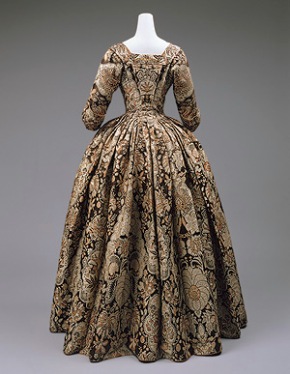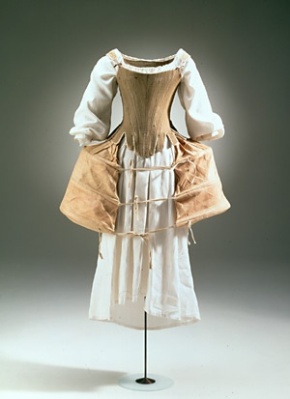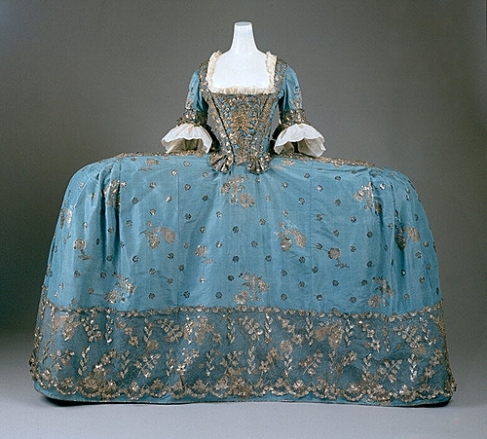Throughout the 18th century, women’s dresses changed constantly as did the concepts of beauty. A noticeable aspect that appeared in England in the beginning of the 18th century was the widespread fashion for extremely large skirts. In order to expand the width of their dresses, women in every social class wore hooped petticoats, which would later be referred to as panniers, after the French word “panier” meaning “basket” since they resembled baskets fastened around a woman’s waist.[1] Even servants could wear small hoops. These panniers were made of wood, whalebone, metal or reeds and were designed to hold out the upper petticoat and skirt. They expanded skirts to widths as large as several feet at each side, so large, that two women could not walk through a doorway at the same time or sit on a couch together, which gave rise to humorous commentary on the part of men. Since wearing such an apparel was not even comfortable for women – indeed it made all their actions like walking, sitting, getting into a carriage require great skill -, it is worth wondering to what extent these big hoops were emblematic of their gender role and what people, notably men, generally thought of it.
A pannier clothing dating from the 18th century
The gender roles assigned to women in the 18th century were very different from those allotted to men. Men, as the stronger sex, were thought to be intelligent, courageous, and determined. Women, on the other hand, were said to be more governed by their emotions, and their virtues were expected to be chastity, modesty and piety.[2] These differences were echoed in the flaws to which each sex was thought to be predisposed. Men were prone to violence and selfishness, while women were associated with vices such as excessive passion, laziness or materialism, which could be seen in the way they dressed up. An eighteenth-century Englishwoman’s world revolved around beauty and domesticity. Prosperous marriage was the goal for most women of the eighteenth century. Beauty, grace and charms were means used to achieve this end. Besides, as the writer Robert W. Jones stated in his book Gender and the Formation of Taste in Eighteenth-Century Britain: “the role and concept of beauty was often used to describe the role and significance of women in eighteenth century society; moreover it was a reference which could both damn and endorse the presence of women, suggesting that they refined society or that they disgraced it with their absurdity and presumption”.
As it happened, the iconic silhouette of the time was that of the rectangularly panniered dress that accentuated the smallness of the waist and enlarged hips. Though, the width of panniers could range from modest to extreme, the larger panniers were generally reserved for formal occasions because they were representative of a woman’s economic status. The larger and the more conspicuous their dresses were, the wealthier women were supposed to be for it required not only a great amount of tissue but also a lot of work from the tailors to make such outfits.
A 1750 English Court Dress
This brocaded silk dress exemplifies the extremes to which panniers were sometimes taken by the mid-eighteenth century. Such a dress enjoyed popularity among British aristocrats as it simultaneously announced the wealth, rank and position (actual or desired) of the wearer.
However, the fashion was quite often pointed out as being ridiculous and women were being made fun of for wearing dresses that spread over so much space.
For instance, in 1750, “The Gentleman’s Magazine” published a satirical article, according to which women themselves wanted to reduce the size of their hoop-petticoats:
“The hoop is but an uncouth addition to us, as it is now modelled, in the eyes of men, who make no scruple to assert, not only that it was the invention of some shoplifter for facilitating the conveyance of stolen goods, but that we look as if we carried a hamper on either side under our coats, and gives us such an enormous croup, as renders us quite out of proportion. We pass along, as it were, balancing between two icales. Every person we meet, every post we pass, and every corner we turn, incumber our way, and obstruct our progress. We fit in a chair hid up to our very ears on either side, like a swan with her head between her lifted wings. The whole side of a coach is hardly capacious enough for one of us. We go up a pair of stairs, as if we were pushing some great burden before us, and with our lifted hoops in our hands, expose such a hollow in coming down as surprises all below us. In short, every convenience attends on our reducing this awkward circumference within a reasonable compass, save only that, as we employ our hands so much in the conduct of it, we may be at a loss how to dispose of them, when it no longer requires their assistance.”
Gen. Advertiser, March 15.
The Gentleman’s Magazine, 1750.
This article called to mind some funny images like that of a woman stealing stuff and hiding it under her dress. It also contrasts with the idea that panniers were intended as a means to display material power.
Among the men that worried about the hoops, some saw them as an indicator that women were announcing independence from the masculine control of their sexual and social lives. They condemned panniers because they were creating private spaces for women. In 1745, an author known as A. W. vehemently attacked the panniers in an essay titled The enormous abomination of the hoop-petticoat. He presented himself as someone who, far from being a woman-hater, spoke in females’ interest and who was moreover in a good position to do so because he was “young enough to retain clear, strong and pleasing ideas of whatsoever is truly beautiful and lovely in the other Sex”. Conjuring up the way their several feet wide skirts made it difficult for women to pass through a door, or get into a coach or even sit on a chair, he asked : “Was ever sight more odious and ridiculous?” and went on by asserting that not only were they inconvenient for the wearers themselves (though he believed that it could even cause death : “Many hundreds, I doubt not, have got their Deaths by them.”) but that they gave trouble to everyone else as well in society. According to him indeed, men were uncomfortable in public assemblies because one woman would take as much space as two or three of them, leaving no room for them. The same thing happened in churches and did not allow men to pray and follow the mass properly. Thus, the writer chided hoops as being incompatible with modesty and piety, which were probably the most important features expected from women at the time : “Modesty which used to be the most amiable and most distinguishing character of That Sex seems now to be as much out of Fashion as the Hoop is in Fashion”. He argued that some went to church only to show off themselves and make a display of their petticoats. In short, he denounced them as being contrary to the law of reason and nature because of its disproportion, its expensiveness and the inconvenience it induced for both women who wore it and their circle of friends and family, or men who simply found themselves around them; and contrary to the law of God “as being inconsistent with the Modesty, Sobriety and Humility of the Christian Religion”. What was probably the most shocking to him was probably the fact that hoops looked like a challenge to men’s domination over women and they emphasized the movement of the hips in a way that exuded female sensuality.
Even some women were critical of the current mode for females as the satirical verses written by Mrs. Selby, who was a mantua-maker in the 18th century, show:
THE FARTHINGALE REVIEWED, OR MORE WORK FOR THE COOPER, 1711
I own the female world is much estranged
From what it was, and top and bottom changed:
The head was once their darling constant care,
But women’s heads can’t heavy burdens bear–
As much, I mean as they can do elsewhere;
So wisely they transferred the mode of dress,
And furnished t’other end with the excess
What tho’ like spires or pyramids they show,
Sharp at the top, and vast of bulk below?
It is a sign they stand the more secure:
A maypole will not like a church endure
And ships at sea, when stormy winds prevail
Are safer in their ballast than their sail.
Quoted in THE CORSET AND THE CRINOLINE
In this poem, she made fun of the way fashion was inconstant and weird, alluding to the extravagant hairstyles that prevailed in the earlier decades and probably gave women headaches, and the way that trend had now been replaced by the craze for panniers, which looked to her like “pyramids”. She associated them with trees so as to suggest that such garments were so heavy and voluminous that nothing, not even a tempest, seemed likely to make women lose their balance. That was ironic as it has often been noticed that women’s large dresses were very uncomfortable and therefore, if one stumbled or tripped over her dress and fell down, that felt like the most shameful thing which could happen to her.
At the same time, some people thought that the extremely wide skirts women wore were truly fashionable. As a response to the virulent work by W.A, Jack Lovelass published in 1745, The hoop-petticoat vindicated, in which he rejected all the arguments that had been put forward by his contemporary fellow. “Great Hoops are so far from being a hurt to the Society, that they are of very singular Service to it; by encouraging and finding Work for a great Number of Hands, that would otherwise be unemployed.” he declared, thus refuting the idea that it was a foolish expense.
Wide skirts grew very popular in the first half of the 18th century, then the size of hoops for everyday wear began to gradually reduce and panniers became out of vogue at the end of the century, though the crinoline would soon replace it and widen the skirts as well. Panniers had been a synonym of feminity throughout the time they were in vogue. Indeed, they emphasized feminine assets valued in European culture such as full hips and bust, separated by a thin waist while tightly covering real shape, especially of legs. Furthermore, the dual position of women as both agents of corruption and idle ornament is one of the most often repeated ideas about women – at least society women – in eighteenth-century culture. Hence, at a time when the role of the women from socially leading bourgeoisie and rising middle class was to take care of the household and reflect the social status of their husband and family, rich dress, restricting movements was becoming a visible mark of a social position. And although several critics of this style emanated, mostly from men, the extreme width of women’s dresses at this period even influenced the architectural style, for instance, James Laver pointed out: “the curved balusters of eighteenth-century staircases.”
Sources :
James Laver, Costume and Fashion, Thames & Hudson, 2002
Robert W. Jones, Gender and the Formation of Taste in Eighteenth-Century Britain: The Analysis of Beauty, Cambridge University Press, 1998
Linda Baumgarten, Eighteenth Century Clothing At Williamsburg, Colonial Williamsburg Foundation, 1986
Article by Irene Lewison Bequest on the Metropolitan Museum of Art Web site, 1973
A. W., Esq, The enormous abomination of the hoop-petticoat, as The Fashion Now is, And has been For about these Two Years Fully Display’d: In some Reflexions upon it, Humbly offer’d to the Consideration of Both Sexes; especially the Female, London, 1745.
Lovelass, Jack, The hoop-Petticoat vindicated, in answer to The Enormous Abomination of the Hoop-Petticoat. By the Ladies most humble Servant Jack Lovelass, London, 1745.
Extract from an article by The Gentleman’s Magazine
Mrs Shelby, The Corset and the Crinoline, 1911



